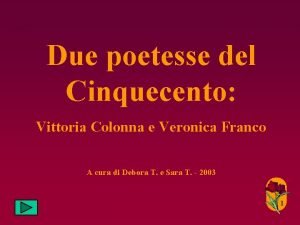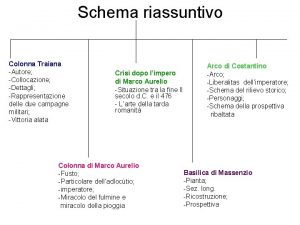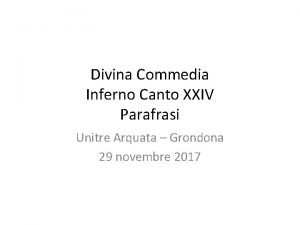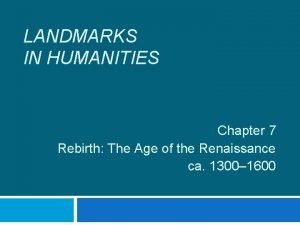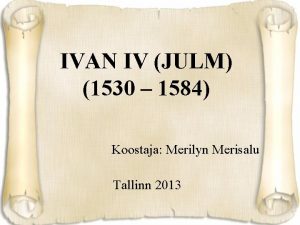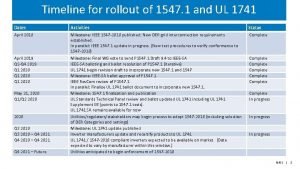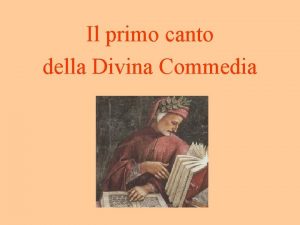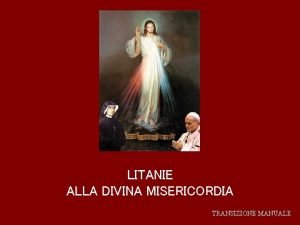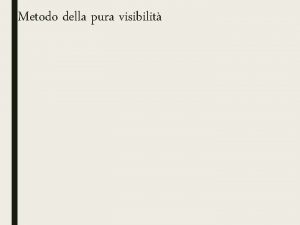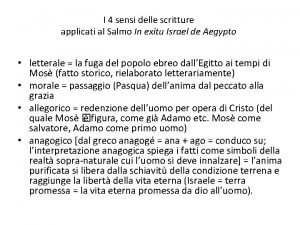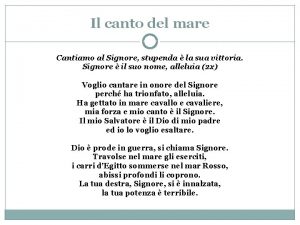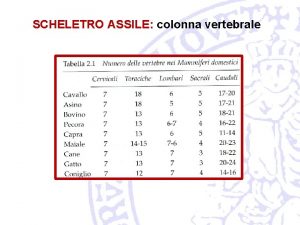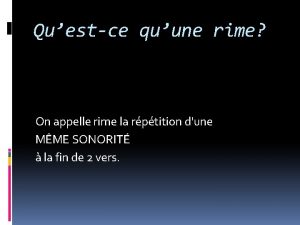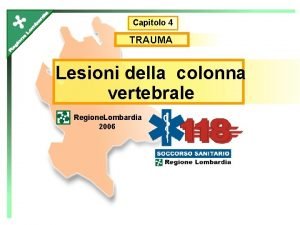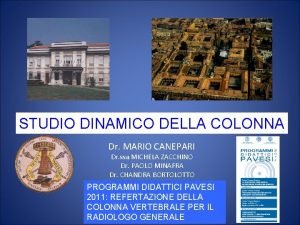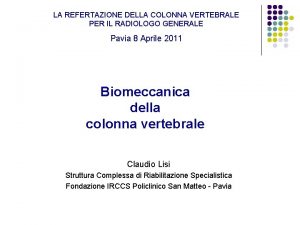Vittoria Colonna 1490 1547 Rime della Divina Vittoria























- Slides: 23

Vittoria Colonna 1490 1547

Rime della Divina Vittoria Colonna (1538) first published book of poetry by a woman � 1559 Ludovico Domenichi publishes Rime diverse d'alcune nobilissime e virtuosissime donne: poems by 93 'most noble and virtuous' women poets �Noble women �Vittoria Colonna (1490 1547) �Veronica Gambara (1485 1550) � self made women or 'honest courtesans' �Tullia d'Aragona (c. 1508 56) �Gaspara Stampa (1523 54) �Veronica Franco (1546 91)

Fabrizio Colonna: father

Vittoria Colonna's life � information incomplete, despite the poet's great fame in her own age � autobiographical readings of Colonna's poetry muddied an already unclear picture � 1490 or 92: born at Marino outside Rome � highly aristocratic family( Fabrizio Colonna and Agnese di Montefeltro) � 1498: betrothed to Francesco Ferrante D'Avalos (political alliance Colonna Family / Ferdinand, king of Naples) � 1509: marriage on the island of Ischia � 1511: D'Avalos leaves home, on military campaigns against the French, which were to occupy him for the rest of his life

Island of Ischia (off the coast of Naples)

Formative years at court on Ischia �childless marriage �D’Avalos and his war heroism becomes subject of her earliest verses �her later spiritual poetry will fuse the earthly captain with Christ �Colonna at the court on Ischia with Costanza D'Avalos a highly learned woman �formative years spent without male protagonists: space for female autonomy.

Widow � 1520: Colonna is in Rome, audience with Pope Leo X, meets Castiglione and Bembo � 1522 25: alternates Naples and her family's estates around Rome � 1525: back to Ischia. Battle of Pavia, D'Avalos dies � 1526: wishes to become a nun. Pope Clement VII denies permission for his political aims �Despite pressure Colonna never consideres remarrying �turns her widowed status to the service of her poetry

Sack of Rome 1527 � 1526: political turmoil in Rome �Colonna family is with the emperor �Vittoria is taken out of the city to the safety of Marino �Despite her family's antipapal stance, she preserves good relations with Clement VII �Proximity to the great seats of power of her age, both papal and imperial � 1527: goes Naples and then Ischia, avoids the brutal Sack of Rome

1527 early 1530 s: in Ischia � Her poetry circulates in manuscripts throughout Italy � Becomes renown as a poet of chaste and devoted love for the memory of her husband � 1530 sends a sonnet to Pietro Bembo, lierary friendship starts and endures until their deaths in 1547. � Becomes closely associated with Capuchin preacher Bernardino Ochino: her style and religious belief are deeply influenced by Ochino’s evangelical and mystical style of preaching � 1536: in Rome again. Is visited by Emperor Charles V who wants her as an intermediary with the Pope � Starts intense friendship with English cardinal Reginald Pole

Matriarch of Petrarchism � 1537: is hosted in Ferrara by Renee de France (wife of Duke Ercole II d'Este) who sympathizes for the Reformation and shelters French religious exiles (including Jean Calvin) � 1539 : in Rome, a friendship with Michelangelo flourishes � 1541: tensions between her brother Ascanio and Pope Paul III force her to Orvieto and then to Viterbo to be near her friend Pole. � 1544: in very poor health returns to Rome and settles in the convent of Sant'Anna de' Funari � 1547: dies and is heralded as the undisputed matriarch of Italian Petrarchism.

Literary Works: Rime amorose � Colonna enjoyed an unprecedented level of literary fame and success for a woman writer � never involved with any of the editions of her work: an aristocratic writer cannot work for acclaim or monetary gain � 1538: first edition of Rime was published: a collection of 145 amorous sonnets (so called rime amorose) � many subsequent editions establish the public image of Colonna as a mournful widow memorializing her lost consort �Her work was well known to an erudite courtly audience but from 1538 a wider public began to know her � The amorous sonnets are heavily influenced by Petrarch, Dante and Bembo

Rime amorose �Traditional theme of the poet who suffers for an impossible love �Gender reversal is entirely new �the love that is mourned has a legitimate public face (her dead husband) �Stylistically the sonnets are carefully controlled and highly finished: Colonna was recognized as an equal to the best male poets of her age

Rime spirituali � 1539: a small selection of spiritual sonnets were appended to the 5 th edition of her work � rime spirituali were always included in editions of the poetry � Editions included woodcut illustrations of the Vittoria clad erroneously in a nun's habit and kneeling in prayer before a crucifix �early editors were as aware as she was herself of the immense marketing power of her piety and were keen to foster the link between the poet's public persona and her work. � rime spirituali were advertised as being a new de parture but there is actually a continuity � D'Avalos in Rime amorose was prefiguring Christ �uniformity of tone and purpose show that she was finding a voice for her religious faith.

Poetic innovator �After 1539 un Petrarchan poetic voice: highly sensual and mystical, reflecting the influence of the evangelical religious circles in which Colonna was moving from the 1530 s �pushes the Petrarchan format in new direction, in both style and theme �Links poetry to a contemporary religious movement and gives it relevance and immediacy (versus traditional Petrarchism known for its courtliness and isolationism � this new spiritual direction to her Petrarchism was Colonna's response to and a reflection of the lyrical language of the Italian reform movement, as in the Beneficio di Cristo.

Lucas Cranach il vecchio, Ritratto di Martin Lutero, Galleria degli Uffizi

Luther’s Reformation � 1517: Martin Luther nails 95 theses in Latin on the door of the castle church in Wittenburg. � popular attack on the venality of Rome � doubts as to the Pope's right to remit punishment inflicted by God � contrition could remit spiritual guilt and nothing else was necessary � 1520 Luther publishes 3 treatises defining his position and calling for action � appeals to the German ruling classes to throw off the yoke of Rome � each believer is their own priest � Breaks the power of the Church over secular authorities the power to give or � � withhold the means of salvation denies four of the traditional sacraments, and keeps only Baptism, the Eucharist, and, a revised Penance Marriage was a civil affair Ordination and confirmation were rites not sacraments. Extreme unction was unscriptural doctrine of justification by faith, free gift of God good works have no heavenly merit

Colonna’s Reformed Spirituality � late 1520 s and early 1530 s, Colonna comes into contact with a the group of aristocrats around Juan de Valdes (among them Bernardino Ochino) �Valdes's theology is a direct challenge to the authority of the church �Bible as the only source for spiritual understanding � no need of the church fathers and institutions �no more money to the church to purchase indulgences for salvation �It is only a short step from this position to an acceptance of the Lutheran doctrine of sola fide, or justification by faith without good works

Sola Fide � People can do nothing to change their fate � They are either saved (justified) or lost only through the power of God's love and the working of their own faith � Good works, prayer, fasting, indulgences, and all the apparatus of Catholicism are therefore meaningless � all that matters is abandoning oneself to the word of God contained in the Bible � in the early 1530 s the Council of Trent had not yet been convened and a clear line between heresy and orthodoxy was yet to be drawn � Vittoria Colonna arrived at a belief in sola fide via a quite orthodox and non Lutheran route � implications of such a doctrine for the individual Christian (poet) �she is handed the responsibility for developing a pure faith through a direct relationship with Christ and his gospels

Colonna’s reformed spirituality � the intimate and loving relationship with D'Avalos of the Rime amorose is superseded by an equally intimate and loving relationship with Christ, �a sensuous and mystical language that reflects the influence of Valdes and Ochino �Frequent allusions to justification by faith �Calvinist concept of predestination ( the elect are born already destined to be saved and equipped with the capacity for faith) � Spirituals or spirituali, around Pole, discussed The Beneficio di Cristo (condemned by the Council of Trent in 1546) � jubilant call to arms to the new faith, expressed in a highly evocative and lyrical language � Vittoria Colonna and her mentor Cardinal Pole wanted to retain a belief in sola fide and remain Catholic � Colonna's death in 1547 meant that she was spared the ignominy of the Inquisition's attentions

Colonna and Michelangelo �were introduced to one another in Rome in 1536 or 1538. �Relationship Reginald Pole/Colonna: guide and mentor �Between Michelangelo and Colonna a very different relationship existed �Colonna: well read, knowledge of Latin, some classical sources, understanding of the scriptures through contact the spirituali, already recognized a skilled poet �Michelangelo was less knowledgeable regarding questions of faith, was of a far lower social status �Colonna assumed the role of spiritual guide and

Manuscript of Sonnets for Michelangelo � 1540: Colonna compiles as a gift for Michelangelo �mutual poetic and spiritual exploration � reflects very clearly the influence of the ecclesia viterbiensis �Many allusions to the doctrinal ideas of the reform (sola fide) �exclusive concentration on the poet's relationship with a loving and forgiving Christ is in line with the Christocentrism of The Beneficio di Cristo

Structure of Sonnets for Michelangelo � All sonnets are rime spirituali � Organization differs from earlier canzonieri that conformed to Petrarch’ s model � a development from the concerns of an earthly love, through a gradual spiritual awakening, to a final prayer to the Virgin Mary (Petrarch’s model) � Here there is no chronological development of the soul, but rather a universal contemplation of the mystery of faith that leads full circle, culminating and beginning in the inevitable fact of the individual and her relationship with Christ. � no aspiration toward escape from earthly love (as in most Petrarchan canzonieri) � Celebration of confinement within a dominating and eternal need for spiritual love � The poet no longer bemoans, but rather celebrates her powerlessness faced by the might and wonder of God and abandons herself to his will � willful self abandonment is in line with the call of the reformers to devote oneself to faith instead of striving to expunge sin through good works

 Vittoria colonna poesie
Vittoria colonna poesie Iiss vittoria colonna
Iiss vittoria colonna La colonna traiana ha delle finestre
La colonna traiana ha delle finestre Canto xxiv inferno testo
Canto xxiv inferno testo Christopher columbus route map
Christopher columbus route map Landmarks in humanities 5th edition
Landmarks in humanities 5th edition Postura descerebrada
Postura descerebrada Miguel de cervantes
Miguel de cervantes Denunciation of images 1547
Denunciation of images 1547 Russia 1547
Russia 1547 Merilyn merisalu
Merilyn merisalu Miguel de cervantes timeline
Miguel de cervantes timeline Molti sono gli animali a cui s'ammoglia
Molti sono gli animali a cui s'ammoglia Litanie alla divina misericordia
Litanie alla divina misericordia Opera della divina consolazione sciacca
Opera della divina consolazione sciacca Il trionfo della divina provvidenza pietro da cortona
Il trionfo della divina provvidenza pietro da cortona 4 sensi della scrittura divina commedia
4 sensi della scrittura divina commedia Alberto bacci
Alberto bacci La vittoria di gaio duilio a milazzo
La vittoria di gaio duilio a milazzo Boccia unior
Boccia unior Dove due o tre sono riuniti nel mio nome canto
Dove due o tre sono riuniti nel mio nome canto Boccia vittoria unior
Boccia vittoria unior Maria vittoria cannatelli
Maria vittoria cannatelli Colonna'''s pizza
Colonna'''s pizza
